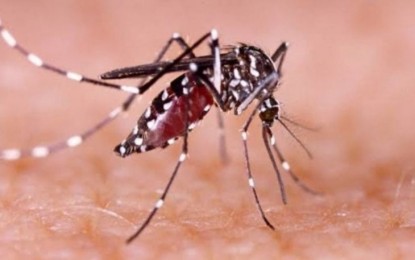
MALARIA MOSQUITO. Malaria cases nationwide increased by 90 percent in 2023, according to Department of Health – Disease Intervention and Prevention Bureau medical officer Kim Patrick Tejano during a press briefing on Friday (April 12, 2024). Malaria is a life-threatening disease caused by parasites transmitted through bites of infected female Anopheles mosquitoes on people. (PNA file photo)
MANILA – Malaria cases in the country almost doubled in 2023 and the Department of Health (DOH) believes that climate change contributed to the uptick.
Latest data from the DOH Research Institute for Tropical Medicine (RITM) showed that about 6,248 cases were recorded in 2023 or 90 percent higher than the 3,245 cases posted in 2022. Of these cases, 11 deaths were reported and still under investigation.
“While the cases and deaths have significantly decreased over the past decade, comparing 2022 and 2023, the cases doubled,” DOH Disease Intervention and Prevention Bureau medical officer Kim Patrick Tejano said in a media Kapihan forum on Friday.
Tejano noted that while several factors contributed to the increase, climate change is being considered one of the major reasons.
“Kung makikita po natin ‘yung pattern ng pag-ulan nung nakaraan sa Palawan, as early as January, February, nakaka-experience po sila ng bagyo, nagkakaroon pa ng maraming (If we look at the pattern of rain last time in Palawan, as early as January, February, they were experiencing typhoons, there was an increase in) streams or breeding sites of anopheles mosquito,” he explained.
Another reason that can be factored into the increase is the lifting of the restrictions imposed during the pandemic.
This provided access to areas where active transmission of malaria cases is present, Tejano said, adding that 684,735 individuals nationwide are now at risk of malaria.
A total of 72 provinces, however, have been declared malaria-free.
Of the 82 provinces, Palawan remains the only province with active cases. It reported a total of 6,188 malaria cases last year.
“Palawan and the City of Puerto Princesa are the remaining areas with active malaria transmission,” Tejano said.
Malaria is a life-threatening disease caused by parasites transmitted through bites of infected female Anopheles mosquitoes on people.
Its symptoms include chills, fever, and sweating, which may repeat every two or three days.
Globally, there are 249 million cases of malaria with 608,000 deaths in 2022.
About 96 percent of malaria deaths were reported in 29 countries, including the Philippines.
Children five years old and below comprise the vulnerable group affected by it.
Malaria is curable and preventable.
The DOH encourages targeted testing and treatment for malaria, which must be directly observed and supervised, with smear examination follow-up to ensure complete parasitological clearance.
Moreover, the DOH provides long-lasting insecticidal nets and materials for indoor residual spraying in malaria-afflicted areas.
